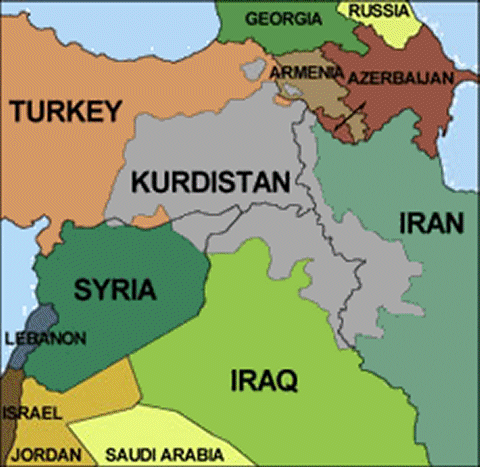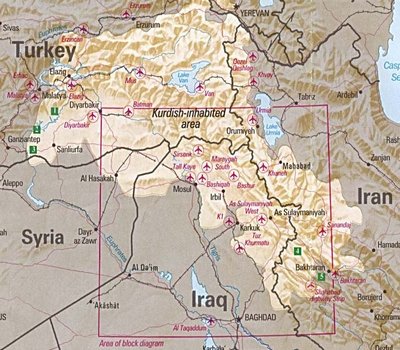



|

|
 |
| Kurdish Question |
|
It was during the Iran-Iraq war that Saddam and the Kurdish question came to the forefront. We need a bit of history again to place the question in context. Where is Kurdistan? It is not a country, yet although there is a solidarity between the Kurdish people there is no Kurdistan. According to wiki (Kurdistan) "In the 16th century, after prolonged wars, Kurdish-inhabited areas were split between the Safavid and Ottoman empires. A major division of Kurdistan occurred in the aftermath of the Battle of Chaldiran in 1514, and was formalized in the 1639 Treaty of Zuhab.[35] Prior to World War I, most Kurds lived within the boundaries of the Ottoman Empire in the province of Kurdistan.[citation needed]. After the collapse of the Ottoman Empire, the Allies contrived to create several countries within its former boundaries – according to the never-ratified Treaty of Sèvres, Kurdistan, along with Armenia, were to be among them. However, the reconquest of these areas by the forces of Kemal Atatürk (and other pressing issues) caused the Allies to accept the renegotiated Treaty of Lausanne and the borders of the modern Republic of Turkey – leaving the Kurds without a self-ruled region. Other Kurdish areas were assigned to the new British and French mandated states of Iraq and Syria. At the San Francisco Peace Conference of 1945, the Kurdish delegation proposed consideration of territory claimed by the Kurds, which encompassed an area extending from the Mediterranean shores near Adana to the shores of the Persian Gulf near Bushehr, and included the Lur inhabited areas of southern Zagros. At the end of the First Gulf War, the Allies established a safe haven in northern Iraq. Amid the withdrawal of Iraqi forces from three northern provinces, Iraqi Kurdistan emerged in 1992 as an autonomous entity inside Iraq with its own local government and parliament." Here is a map of land that might be called Kurdistan:-  There are Kurds within national boundaries of Iraq, Iran, Turkey, Armenia and Syria. Now look at this contour map of Kurdistan:-  Aren't the Kurdish regions mountain regions? Isn't it likely that there will be a greater affinity between the mountain Kurds of Iran and Iraq than with Arab peoples in the plains of Baghdad? When you add to this the fact, according to Wiki, that their land has been divided between the Turkish, Britsh state of Iraq and the French state of Syria, less than a century before, and that they are still seeking recognition of a territory called Kurdistan, the allegiance of the Kurds is going to be to themselves rather than some arbitrary leader - even if that leader was not a tyrant. Is there any history of struggle involving the Kurds prior to the Iran-Iraq war? From Reuter's we have:- " * Kurds in northern Iraq -- under a British mandate -- revolt in 1919, 1923 and 1932, but are crushed. * Under Mustafa Barzani, they wage an intermittent struggle against Baghdad. * 1970: Baghdad grants Kurds language rights and self rule, but deal breaks down partly over oil revenues. * 1974: New clashes erupt; Iraqis force 130,000 Kurds into Iran. But Iran withdraws support for Kurds the following year. * 1988: Iraqis launch poison-gas attack, killing 5,000 Kurds in town of Halabja. * 1991: After Persian Gulf War, northern Iraq's Kurdish area comes under international protection. * 1999: Two rival Iraqi Kurdish factions, one led by Mustafa Barzani's son Massoud, the other by Jalal Talabani, broker a peace deal; goal is for Kurdish area to become part of a democratic Iraq.' quoted in the Washington Post. Here is a description of how Saddam viewed the Iraqi people:- "Ethnic Cleansing: The two dominant ethnicities of Iraq have traditionally been Arabs in south and central Iraq, and Kurds in the north and northeast, particularly along the Iranian border. Hussein long viewed ethnic Kurds as a long-term threat to Iraq's survival, and the oppression and extermination of the Kurds was one of his administration's highest priorities. Religious Persecution: The Baath Party was dominated by Sunni Muslims, who made up only about one-third of Iraq's general population; the other two-thirds was made up of Shiite Muslims, Shiism also happening to be the official religion of Iran. Throughout Hussein's tenure, and especially during the Iran-Iraq War (1980-1988), he saw the marginalization and eventual elimination of Shiism as a necessary goal in the Arabization process, by which Iraq would purge itself of all perceived Iranian influence. The Dujail Massacre of 1982: In July of 1982, several Shiite militants attempted to assassinate Saddam Hussein while he was riding through the city. Hussein responded by ordering the slaughter of some 148 residents, including dozens of children. This is the only war crime on which Hussein has been charged, and he will almost certainly be executed before any other charges go to trial. The Barzani Clan Abductions of 1983: Masoud Barzani led the Kurdistan Democratic Party (KDP), an ethnic Kurdish revolutionary group fighting Baathist oppression. After Barzani cast his lot with the Iranians in the Iran-Iraq War, Hussein had some 8,000 members of Barzani's clan, including hundreds of women and children, abducted. It is assumed that most were slaughtered; thousands have been discovered in mass graves in southern Iraq. The al-Anfal Campaign: The worst human rights abuses of Hussein's tenure took place during the genocidal al-Anfal Campaign (1986-1989), in which Hussein's administration called for the extermination of every living thing--human or animal--in certain regions of the Kurdish north. All told, some 182,000 people--men, women, and children--were slaughtered, many through use of chemical weapons. The Halabja poison gas massacre of 1988 alone killed over 5,000 people. Hussein later blamed the attacks on the Iranians, and the Reagan administration, which supported Iraq in the Iran-Iraq War, helped promote this cover story. The Campaign Against the Marsh Arabs: Hussein did not limit his genocide to identifiably Kurdish groups; he also targeted the predominantly Shiite Marsh Arabs of southeastern Iraq, the direct descendants of the ancient Mesopotamians. By destroying more than 95% of the region's marshes, he effectively depleted its food supply and destroyed the entire millennia-old culture, reducing the number of Marsh Arabs from 250,000 to approximately 30,000. It is unknown how much of this population drop can be attributed to direct starvation and how much to migration, but the human cost was unquestionably high." In addition a Toronto Star reporter wrote "freelancer Trevor Rowe .... an intriguing piece of information. Rowe reported the Iraqi forces had attacked Halabja when it "was occupied by Iranian troops. Five thousand Kurdish civilians were reportedly killed."" So what does all this information tell us about the Saddam and the Kurds. The man was a tyrant who was trying to defend an ethnic position in which he had a minority dictatorship of 1/3 Sunni muslims. Such a dictatorship should never have been given any credence, and yet until 1990 he was supported by the West and in that time killed 180,000 Kurds in the al-Anfal campaign, more than 200,000 Shiite Marsh Arabs, and however many more. By the logic of a tyrant he had to destroy the threat of the Kurds who had fought, or were fighting, a war against him. Is this any worse than bombing Afghanistan to find Osama bin Laden? Saddam did not single out the Kurds and his policy towards the Kurds did not change before the First Gulf war and afterwards, yet from supporting this policy prior to the Gulf War this same policy became a moral justification for western allies to go to war. Whilst some efforts have been made in terms of a Kurdish Autonomous region in Iraq, have there been any other efforts to resolve this Kurdish question by negotiating a Kurdish homeland - a Kurdistan - a problem that was caused by a western war nearly 100 years ago? |
| Send comment:- |
Tags - |
| Back to Iraq links page / Reflections on a war |